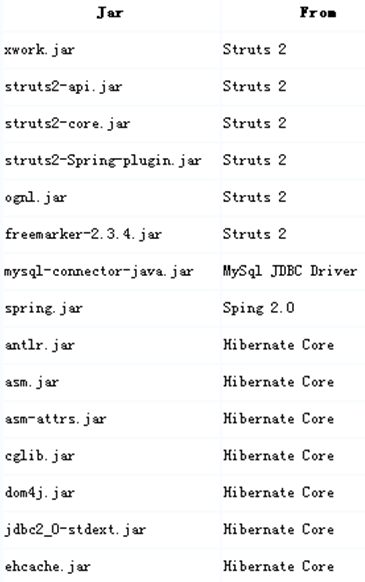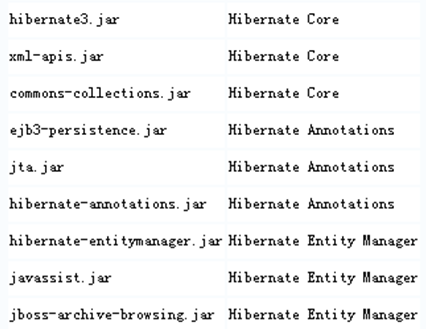Posted on 2009-02-27 15:48
啥都寫點 閱讀(1197)
評論(0) 編輯 收藏 所屬分類:
J2EE



Person類代碼
package quickstart.model;��import javax.persistence.Entity;�import javax.persistence.GeneratedValue;�import javax.persistence.Id;��
@Entity
public class Person {�
@Id�
@GeneratedValue�
private Integer id;�
private String lastName;�
private String firstName;��
public String getFirstName() {�
return firstName;�
}��
public void setFirstName(String firstName) {�
this.firstName = firstName;�
}�� public String getLastName() {�
return lastName;�
}�� public void setLastName(String lastName) {�
this.lastName = lastName;�
}�� public Integer getId() {�
return id;�
}�� public void setId(Integer id) {�
this.id = id;�
}
}
創(chuàng)建一個接口,命名為"PersonService",包名為"quickstart.service" PersonService.java
package quickstart.service;��import java.util.List;��import quickstart.model.Person;��public interface PersonService {�
public List<Person> findAll();�
public void save(Person person);��
public void remove(int id);��
public Person find(int id);�}
創(chuàng)建一個類,命名為"PersonServiceImpl",包名為"quickstart.service"PersonServiceImpl.java
package quickstart.service;
import java.util.List;��
import javax.persistence.EntityManager;
import javax.persistence.PersistenceContext;�
import javax.persistence.Query;��
import org.springframework.transaction.annotation.Transactional;
import quickstart.model.Person;
@Transactional
public class PersonServiceImpl implements PersonService {�
private EntityManager em;��
@PersistenceContext�
public void setEntityManager(EntityManager em) {�
this.em = em;�
}��
@SuppressWarnings("unchecked")�
public List<Person> findAll() {�
Query query = getEntityManager().createQuery("select p FROM Person p");�
return query.getResultList();�
}��
public void save(Person person) {�
if (person.getId() == null) {�
// new� em.persist(person);�
} else {�
// update� em.merge(person);� }�
}��
public void remove(int id) {�
Person person = find(id);�
if (person != null) {�
em.remove(person);�
}�
}��
private EntityManager getEntityManager() {�
return em;�
}��
public Person find(int id) {�
return em.find(Person.class, id);�
}
}
@PersistenceContext會讓Spring在實例化的時候給服務注入一個EntityManager。@PersistenceContext注解可以放在實例變量,或者setter方法前面。如果一個類被注解為@Transactional,Spring將會確保類的方法在運行在一個事務中。
JPA配置
persistence.xml中就不用配置了,因為會教給spring保管
web.xml的配置
<?xml version="1.0" encoding="UTF-8"?>
�<web-app id="person" version="2.4"
xmlns="http://java.sun.com/xml/ns/j2ee"�
xmlns:xsi="http://www.w3.org/2001/XMLSchema-instance"� xsi:schemaLocation="http://java.sun.com/xml/ns/j2ee http://java.sun.com/xml/ns/j2ee/web-app_2_4.xsd">� <display-name>person</display-name>�
<filter>�
<filter-name>struts2</filter-name>�
<filter-class>�org.apache.struts2.dispatcher.FilterDispatcher�</filter-class>�
</filter>��
<filter-mapping>�
<filter-name>struts2</filter-name>
<url-pattern>/*</url-pattern>�
</filter-mapping>���
<welcome-file-list>�
<welcome-file>index.jsp</welcome-file>�
</welcome-file-list>��
<listener>�
<listener-class>org.springframework.web.context.ContextLoaderListener�</listener-class>�
</listener>�
</web-app>
applicationContext.xml配置如下:
<?xml version="1.0" encoding="UTF-8"?>�<beans xmlns="http://www.springframework.org/schema/beans"� xmlns:xsi="http://www.w3.org/2001/XMLSchema-instance"� xmlns:aop="http://www.springframework.org/schema/aop"� xmlns:tx="http://www.springframework.org/schema/tx"� xsi:schemaLocation="� http://www.springframework.org/schema/beans http://www.springframework.org/schema/beans/spring-beans-2.0.xsd� http://www.springframework.org/schema/tx http://www.springframework.org/schema/tx/spring-tx-2.0.xsd� http://www.springframework.org/schema/aop http://www.springframework.org/schema/aop/spring-aop-2.0.xsd">��
<bean� class="org.springframework.orm.jpa.support.PersistenceAnnotationBeanPostProcessor" />��
<bean id="personService" class="quickstart.service.PersonServiceImpl" />��
<bean id="entityManagerFactory"� class="org.springframework.orm.jpa.LocalContainerEntityManagerFactoryBean">�
<property name="dataSource" ref="dataSource" />�
<property name="jpaVendorAdapter">�
<bean� class="org.springframework.orm.jpa.vendor.HibernateJpaVendorAdapter">�
<property name="database" value="MYSQL" />�
<property name="showSql" value="true" />�
</bean>�
</property>�
</bean>��
<bean id="dataSource"� class="org.springframework.jdbc.datasource.DriverManagerDataSource">�
<property name="driverClassName" value="com.mysql.jdbc.Driver" />�
<property name="url" value="jdbc:mysql://localhost/test" />�
<property name="username" value="root" />�
<property name="password" value="root" />�
</bean>��
<bean id="transactionManager"� class="org.springframework.orm.jpa.JpaTransactionManager">�
<property name="entityManagerFactory" ref="entityManagerFactory" />�
</bean>��
<tx:annotation-driven transaction-manager="transactionManager" />��
<bean id="personAction" scope="prototype"� class="quickstart.action.PersonAction">�
<constructor-arg ref="personService" />�
</bean>
</beans>
注意"personAction"bean的"class"屬性被設為Action類的名字,并且"personService"bean會作為參數傳遞到action的構造器中。改變"dataSource"Bean的"url",
"username"和"passwrod"屬性為你數據庫的值。更多beans設置的細節(jié),請參看Spring的文檔。"scope"是Spring2新增的屬性,它意味著Spring會在該類型的對象被請求時創(chuàng)建一個新的PersonAction對象。在Struts2里,一個新的action對象被創(chuàng)建,用來為每個請求服務,這就是我們?yōu)槭裁葱枰?/span>scope="prototype"。
現在我們需要創(chuàng)建一個簡單的Struts action,它封裝了PersonServices的方法。并且我們配置Struts使用Spring作為對象工廠。
打開新建類對話框,輸入"PersonAction"作為類名,包名為"quickstart.action",內容如下:
package quickstart.action;
import java.util.List;
import quickstart.model.Person;
import quickstart.service.PersonService;��
import com.opensymphony.xwork2.Action;
import com.opensymphony.xwork2.Preparable;��
public class PersonAction implements Preparable {�
private PersonService service;�
private List<Person> persons;�
private Person person;�
private Integer id;��
public PersonAction(PersonService service) {�
this.service = service;�
}��
public String execute() {�
this.persons = service.findAll();�
return Action.SUCCESS;�
}��
public String save() {�
this.service.save(person);�
this.person = new Person();�
return execute();�
}��
public String remove() {�
service.remove(id);�
return execute();�
}��
public List<Person> getPersons() {�
return persons;�
}��
public Integer getId() {�
return id;�
}��
public void setId(Integer id) {�
this.id = id;�
}��
public void prepare() throws Exception {�
if (id != null)�
person = service.find(id);�
}��
public Person getPerson() {�
return person;�
}��
public void setPerson(Person person) {�
this.person = person;�
}
}
struts.xml中的配置
<?xml version="1.0" encoding="UTF-8" ?>�<!DOCTYPE struts PUBLIC� "-//Apache Software Foundation//DTD Struts Configuration 2.0//EN"� "http://struts.apache.org/dtds/struts-2.0.dtd">�<struts>�
<constant name="struts.objectFactory" value="spring" />�
<constant name="struts.devMode" value="true" />��
<package name="person" extends="struts-default">��
<action name="list" method="execute" class="personAction">�
<result>pages/list.jsp</result>�
<result name="input">pages/list.jsp</result>�
</action>��
<action name="remove" class="personAction" method="remove">�
<result>pages/list.jsp</result>�
<result name="input">pages/list.jsp</result>�
</action>��
<action name="save" class="personAction" method="save">�
<result>pages/list.jsp</result>�
<result name="input">pages/list.jsp</result>�
</action>�
</package>��
</struts>
設置"struts.objectFactory"為"spring"會強制Struts使用Spring來實例化action,并注入所有定義在applicationContext.xml中的依賴關系。每個action別名的"class"屬性被設置為"personAction",這也就是我們在applicationContext.xml中定義的PersonAction bean。要讓Struts與Spring一起工作,我們僅僅需要做上面這點事情。
--  學海無涯
學海無涯